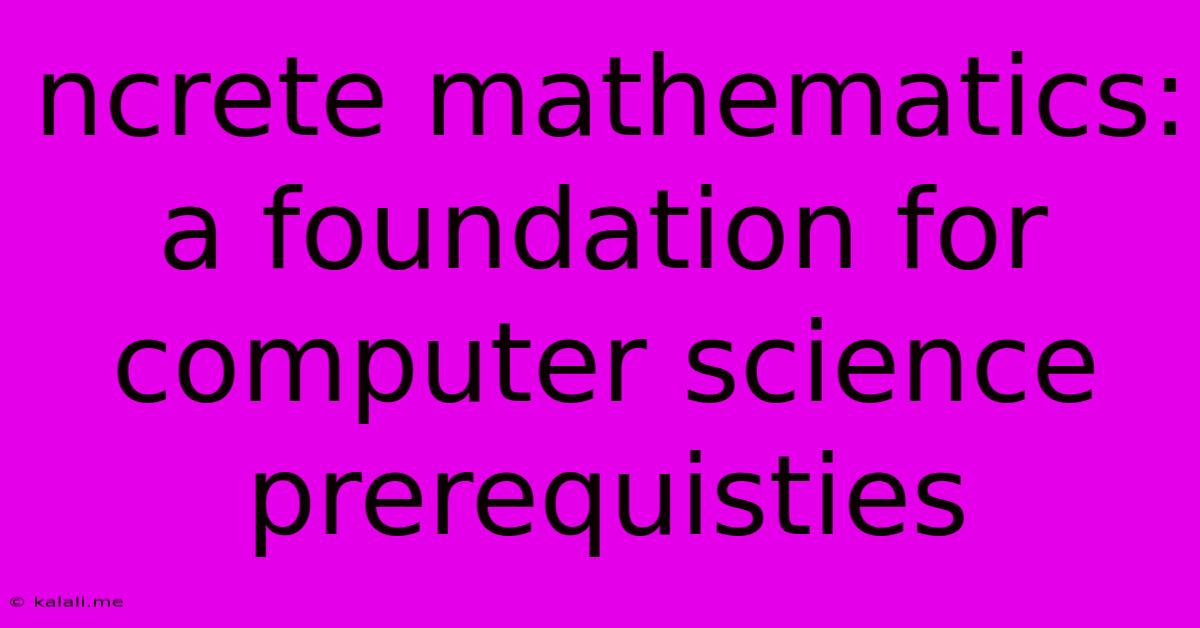Ncrete Mathematics: A Foundation For Computer Science Prerequisties
Kalali
May 25, 2025 · 3 min read

Table of Contents
Concrete Mathematics: A Foundation for Computer Science Prerequisites
Meta Description: This article explores Concrete Mathematics, a crucial foundation for computer science, detailing its core concepts, applications, and prerequisites to help aspiring computer scientists prepare effectively. We'll cover summations, recurrences, and asymptotics, highlighting their importance in algorithm analysis and design.
Concrete Mathematics, a foundational text by Graham, Knuth, and Patashnik, isn't your typical mathematics textbook. It's a powerful tool specifically designed to equip computer scientists with the mathematical skills necessary to tackle complex algorithmic problems and theoretical concepts. While often perceived as daunting, understanding its core principles is crucial for success in many computer science disciplines. This article will delve into its key components and help you understand why it’s considered such a valuable resource.
What is Concrete Mathematics?
Concrete Mathematics bridges the gap between the abstract world of pure mathematics and the practical needs of computer science. It emphasizes techniques and methodologies directly applicable to the analysis and design of algorithms and data structures. Instead of focusing on abstract proofs, it concentrates on developing a strong intuition and practical problem-solving skills related to discrete mathematics. This means dealing with finite, rather than continuous, quantities.
Core Concepts Explored in Concrete Mathematics:
Several key mathematical areas form the bedrock of Concrete Mathematics:
-
Summations: Understanding how to manipulate and evaluate sums is fundamental in computer science. Algorithms often involve iterative processes, and analyzing their runtime complexity frequently requires evaluating summations. Concrete Mathematics provides powerful techniques for simplifying and solving complex summations efficiently. This includes mastering techniques like the summation operator, arithmetic series, geometric series, and telescoping sums.
-
Recurrences: Many algorithms are naturally defined recursively. Analyzing the time and space complexity of recursive algorithms requires solving recurrence relations. Concrete Mathematics introduces various methods for solving recurrences, including the substitution method, the recursion-tree method, and the Master Theorem. Mastering these techniques is vital for understanding the efficiency of recursive algorithms like merge sort and quicksort.
-
Asymptotic Analysis: Asymptotic analysis is crucial for comparing the efficiency of different algorithms. Concrete Mathematics delves into Big O notation (O), Big Omega notation (Ω), and Big Theta notation (Θ), providing the tools to describe the growth rate of functions and compare algorithms based on their asymptotic complexity. Understanding this is essential for selecting the most efficient algorithm for a given task.
-
Generating Functions: These are powerful tools for solving recurrence relations and analyzing combinatorial problems. Concrete Mathematics introduces the concept of generating functions and shows how to use them to find closed-form solutions for recurrence relations that might otherwise be difficult to solve.
-
Discrete Probability: A foundational understanding of probability is crucial for algorithm analysis and the design of randomized algorithms. Concrete Mathematics provides a solid introduction to discrete probability, including concepts like expectation and variance.
Prerequisites for Understanding Concrete Mathematics:
While Concrete Mathematics is challenging, it's not insurmountable. A solid foundation in the following areas will significantly ease the learning process:
- High School Algebra: A strong grasp of algebraic manipulation and equation solving is essential.
- Precalculus: Familiarity with functions, sequences, and series is beneficial.
- Basic Calculus: While not strictly required for all parts of the book, a basic understanding of calculus, particularly limits and derivatives, will enhance your comprehension of certain concepts.
- Discrete Mathematics: A prior course in discrete mathematics covering topics like sets, logic, and graph theory, while not explicitly required, is highly recommended to build a foundational understanding.
Why is Concrete Mathematics Important for Computer Science?
Concrete Mathematics provides the mathematical toolkit necessary to:
- Analyze algorithm efficiency: Determine the time and space complexity of algorithms.
- Design efficient algorithms: Develop algorithms that are optimized for performance.
- Understand data structures: Analyze the performance characteristics of different data structures.
- Solve complex computational problems: Apply mathematical techniques to solve challenging problems.
In conclusion, Concrete Mathematics is a demanding but rewarding undertaking for aspiring computer scientists. By mastering its concepts, you'll acquire the mathematical maturity necessary to tackle advanced topics and contribute meaningfully to the field. Remember to approach it methodically, building a strong foundation in the prerequisites before diving into its complexities. The investment of time and effort will pay significant dividends in your computer science journey.
Latest Posts
Latest Posts
-
Greasy Condition Of Carnitas For Example
May 25, 2025
-
Frozen Jack Nicholson In The Shining
May 25, 2025
-
Lyrics To The Song 7 By Prince
May 25, 2025
-
My Furnace Is Blowing Cold Air
May 25, 2025
-
Exim Failed To Fork Automatic Delivery Process Resource Temporarily Unavailable
May 25, 2025
Related Post
Thank you for visiting our website which covers about Ncrete Mathematics: A Foundation For Computer Science Prerequisties . We hope the information provided has been useful to you. Feel free to contact us if you have any questions or need further assistance. See you next time and don't miss to bookmark.